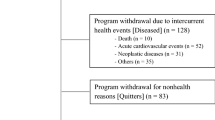Abstract
We aimed to investigate the characteristics of changes in amount of physical activity of patients with peripheral arterial disease (PAD) before/after endovascular treatment (EVT) combined with exercise training. Twenty-two patients with peripheral arterial disease at stage-II of the Fontaine classification who received EVT combined with exercise training were included in this study. A tri-axial accelerometer was used to record physical activity every day from the day before surgery to 3 months after discharge from hospital. The mean number of walking steps before surgery was 2664 steps (611 steps–5404 steps), whereas those after surgery was 3393 (567 steps–7578 steps). Ankle Brachial Index (from 0.69 to 1.03; p < 0.001), maximum walking distance (from 728.2 to 1271.8 m; p < 0.05) and Vascu-QOL (from 98.9 to 137.9; p < 0.01) showed improvement between before and after surgery. Physical activity of patients with PAD was still low at 3 months after surgery even though walking ability, QOL, and self-efficacy were improved after EVT combined with exercise training. Among the 22 patients, the number of walking steps increased in 17 of them and decreased in 5 of them. Compared with the patients in the increased-steps group, those in the decreased-steps group were significantly older (p < 0.05), and had a significantly higher cardiovascular event rate within the first 3 months after surgery (p < 0.05). These results suggested that, not only the improvement of walking ability, but increase in physical activity after EVT combined with exercise training is also important for short-term prognosis.
Similar content being viewed by others
References
Annual report on national survey for number of vascular surgery in Japan 2012. http://www.jsvs.org/ja/enquete/aggregate_2012-2.pdf
Greenhalgh RM, Belch JJ, Brown LC, Gaines PA, Gao L, Reise JA, Thompson SG, Participants Mimic Trial (2008) The adjuvant benefit of angioplasty in patients with mild to moderate intermittent claudication (MIMIC) managed by supervised exercise, smoking cessation advice and best medical therapy: results from two randomised trials for stenotic femoropopliteal and aortoiliac arterial disease. Eur J Vasc Endovasc Surg 36(6):680–688
Parmenter BJ, Dieberg G, Smart NA (2015) Exercise training for management of peripheral arterial disease: a systematic review and meta-analysis. Sport Med 45:231–244
Kruidenier LM, Nicolai SP, Rouwet EV, Peters RJ, Prins MH, Teijink JAW (2011) Additional supervised exercise therapy after a percutaneous vascular intervention for peripheral arterial disease: a randomized clinical trial. J Vasc Interv Radiol 22:961–968
Frans FA, Bipat S, Reekers JA, Legemate DA, Koelemay MJ (2012) Systematic review of exercise training or percutaneous transluminal angioplasty for intermittent claudication. Br J Surg 99(1):16–28
McDermott MM, Liu K, O’Brien E, Guralnik JM, Criqui MH, Martin GJ, Greenland P (2000) Measuring physical activity in peripheral arterial disease: a comparison of two physical activity questionnaires with an accelerometer. Angiology 51(2):91–100
Lauret GJ, Fokkenrood HJ, Bendermacher BL, Scheltinga MR, Teijink JA (2014) Physical activity monitoring in patients with intermittent claudication. Eur J Vasc Endovasc Surg 47(6):656–663
Gardner AW, Montgomery PS, Scott KJ, Afaq A, Blevins SM (2007) Patterns of ambulatory activity in subjects with and without intermittent claudication. J Vasc Surg 46(6):1208–1214
Garg PK, Liu K, Tian L, Guralnik JM, Ferrucci L, Criqui MH, Tan J, McDermott MM (2009) Physical activity during daily life and functional decline in peripheral arterial disease. Circulation 119(2):251–260
Leeper NJ, Myers J, Zhou M, Nead KT, Syed A, Kojima Y, Caceres RD, Cooke JP (2013) Exercise capacity is the strongest predictor of mortality in patients with peripheral arterial disease. J Vasc Surg 57(3):728–733
Norgren L, Hiatt WR, Dormandy JA, Nehler MR, Harris KA, Fowkes FG, TASC II Working Group (2007) Inter-Society Consensus for the Management of Peripheral Arterial Disease (TASC II). J Vasc Surg 45(Suppl S):S5–67
Hiatt WR, Hirsch AT, Reqensteiner JG, Brass EP (1995) Clinical trials for claudication. Assessment of exercise performance, functional status, and clinical end points. Vascular Clinical Trialists. Circulation 92(3):614–621
Zigmond AS, Snaith RP (1983) The Hospital Anxiety and Depression Scale. Acta Psychiatr Scand 67(6):361–370
Ewart CK, Taylor CB, Reese LB, DeBusk RF (1983) Effects of early postmyocardial infarction exercise testing on self-perception and subsequent physical activity. Am J Cardiol 51(7):1076–1080
Morgan MB, Crayford T, Murrin B, Fraser SC (2001) Developing the Vascular Quality of Life Questionnaire: a new disease-specific quality of life measure for use in lower limb ischemia. J Vasc Surg 33(4):679–687
Murphy TP, Hirsch AT, Ricotta JJ, Cutlip DE, Mohler E, Regensteiner JG, Comerota AJ, Cohen DJ, CLEVER Steering Committee (2012) Supervised exercise vs primary stenting for claudication due to aortoiliac peripheral disease: 6-month outcomes from the CLEVER Study. Circulation 125(1):130–139
Fakhry F, Spronk S, van der Laan L, Wever JJ, Teijink JA, Hoffmann WH, Smits TM, van Brussel JP, Stultiens GN, Derom A, den Hoed PT, Ho GH, van Dijk LC, Verhofstad N, Orsini M, van Petersen A, Woltman K, Hulst I, van Sambeek MR, Rizopoulos D, Rouwet EV, Hunink MG (2015) Endovascular revascularization and supervised exercise for peripheral artery disease and intermittent claudication. A randomized clinical trial. JAMA 314(18):1936–1944
Spronk S, Bosch JL, den Hoed PT, Veen HF, Pattynama PM, Hunink MG (2009) Intermittent claudication: clinical effectiveness of endovascular revascularization versus supervised hospital-based exercise training—randomized controlled trial. Radiology 250(2):586–595
Lundgren F, Dahllöf AG, Lundholm K, Scherstén T, Volkmann R (1989) Intermittent claudication—surgical reconstruction or physical training? A prospective randomized trial of treatment efficiency. Ann Surg 209(3):346–355
Koba S, Tanaka H, Maruyama C, Tada N, Birou S, Teramoto T, Sasaki J (2011) Physical activity in the Japan population: association with blood lipid levels and effects in reducing cardiovascular and all-cause mortality. J Atheroscler Thromb 18(10):833–845
National Health and Nutrition Examination Survey in Japan (2013). http://www.mhlw.go.jp/stf/houdou/0000067890.html
Acknowledgments
This work was supported by JSPS KAKENHI Grant Number 26670964.
Author information
Authors and Affiliations
Corresponding author
Ethics declarations
Conflict of interest
There is no conflict of interests to disclose.
Rights and permissions
About this article
Cite this article
Otsuka, S., Morisawa, T., Yuguchi, S. et al. Clinical importance of change in physical activity after endovascular treatment combined with exercise training in patients with peripheral arterial disease. Heart Vessels 32, 143–148 (2017). https://doi.org/10.1007/s00380-016-0856-4
Received:
Accepted:
Published:
Issue Date:
DOI: https://doi.org/10.1007/s00380-016-0856-4



